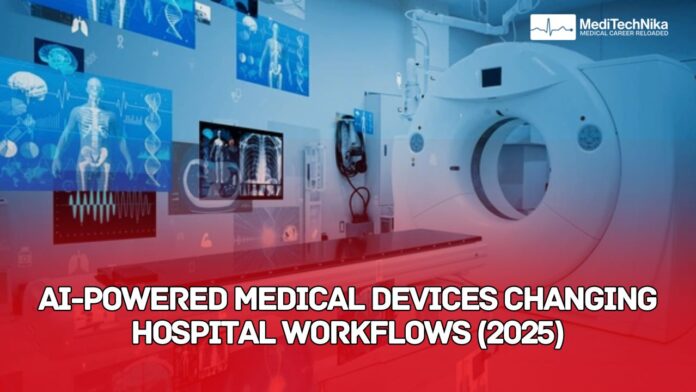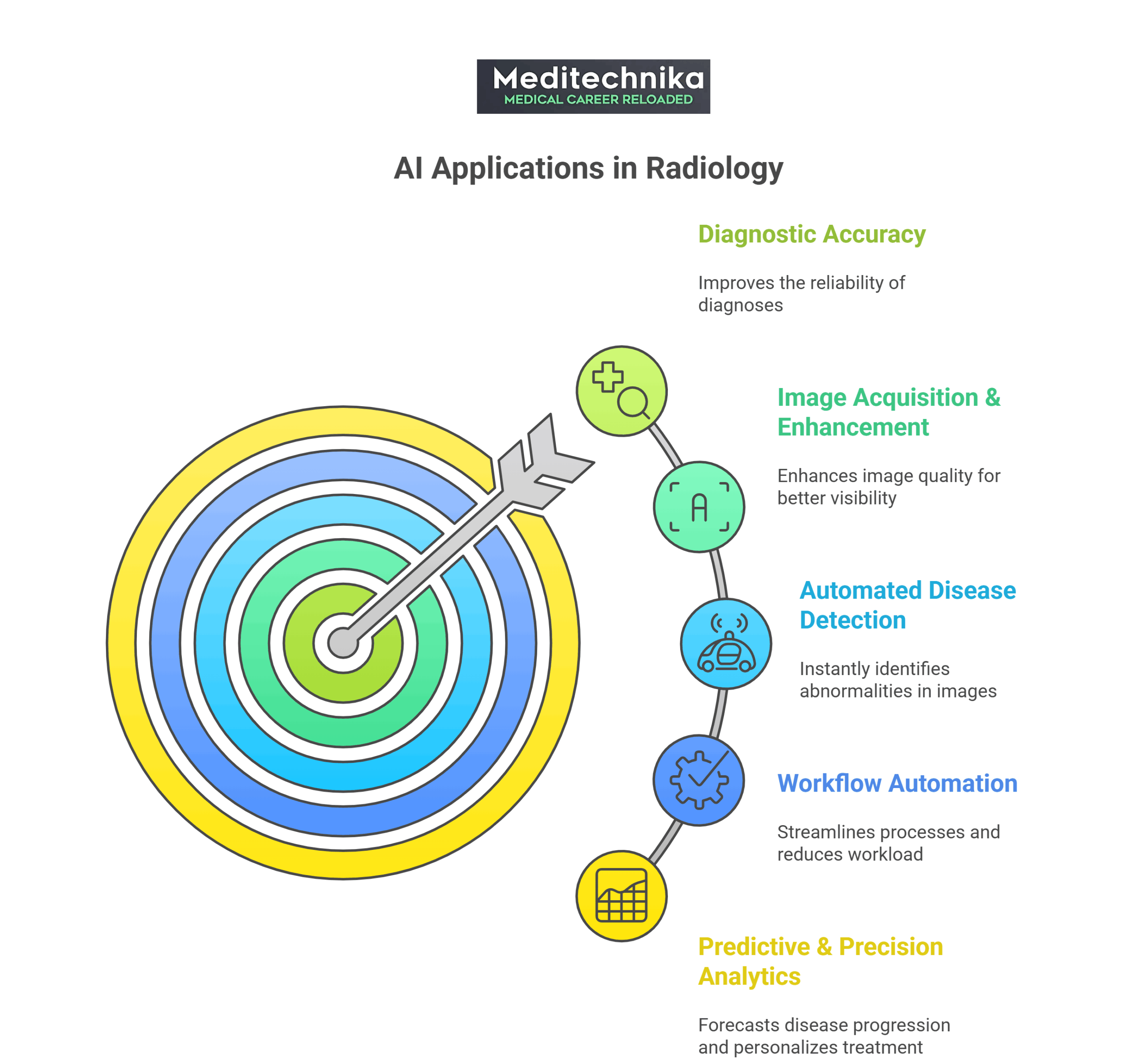Artificial Intelligence In Healthcare: Medical Devices Changing Hospital Workflow (2025)
Artificial Intelligence in Healthcare: Hospitals globally are increasingly turning to AI-powered tools with the help of artificial intelligence in the healthcare sector to ensure efficiency, reduce diagnostic errors, and change how health is practiced. The experiments have now become the norm with the help of AI medical devices and equipment. Also, the workflow level of healthcare automation is being incorporated across the emergency rooms, radiology suites, ICUs, and outpatient clinics.
Today, with increase in the use of AI in hospitals is notable in every department, especially in imaging, diagnostics, and critical care. These developments help to enhance the speed and accuracy, where AI for medical imaging and AI in radiology play an important role in healthcare.
Here are the top 10 game-changing AI-powered devices that are helping to improve patient care with regulatory status and workflow advantages.
1. IDx-DR Autonomous Diabetic Retinopathy Screening
IDx-DR is one of the AI-powered medical devices in the healthcare sector. This is an autonomous screening tool that detects diabetic retinopathy, a condition where diabetes damages the blood vessels in the retina of the eye, which leads to blurred vision.
This particular medical device helps to diagnose this condition without a specialist present. It helps to reduce the dependency on ophthalmologists, leading to faster screening in primary care centers, which leads to early detection for better treatment options.
2. Viz.ai Stroke Triage Automation
Viz. ai is another game-changing medical device that uses artificial intelligence algorithms to detect and diagnose large vessel occlusion (LVO) strokes. This device helps to advance emergency stroke care by interpreting the CT scan and helping the experts.
It is an AI-powered detection that analyzes computed tomography angiography (CTA) scans to detect large vessel occlusions within minutes. This also helps physicians to access and review the images on smartphones and tablets, providing real-time mobile access.
It also helps to improve workflow efficiency, reduce time, and enhance accuracy. This device also shows how AI in radiology can be improved for better patient outcomes.
3. Caption guidance: AI-guided ultrasound
An AI-powered medical device that is used for ultrasound scans, particularly for cardiology, which provides real-time guidance not only for the professionals but also for the non-experts on how to use, move, and position the ultrasound probe.
It also has an automated image capture feature that captures the image and saves the best image, reducing the manual workload. This medical device technology improves the accuracy, with rapid efficiency, boosting confidence in the users to perform scans.
Caption guidance uses AI to perform cardiac imaging, leading to broader adoption of AI in hospitals and AI in medical imaging.
4. Eko DUO / AI Stethoscope
The Eko DUO is an advanced medical tool that combines a digital stethoscope with an ECG. It is a handheld device that uses AI to help healthcare experts detect heart-related diseases and abnormalities in the lungs.
This device captures both heart and lung sounds and ECG data simultaneously. It also has a great feature that amplifies the audio and eliminates the unnecessary noise. Another ultimate feature of this particular medical device is that it can be connected wirelessly through Bluetooth to iOS and Android devices, which allows clinical experts to visualize phonocardiograms (PCG) and ECG in real time.
The best use of this medical device is immediate bedside screening with reduced unnecessary noises, supporting faster cardiac triage.
5. Prenosis Sepsis ImmunoScore
Prenosis is the first and only FDA-authorized diagnostic tool with the combination of AI/ML that is used to predict sepsis. It is an AI-powered software that is incorporated into the electronic health record system to help clinical professionals identify developing sepsis within 24 hours.
This device uses artificial intelligence and machine learning algorithms to identify different clinical parameters like blood pressure, heart rate, and respiratory rate. This is also used to analyze the sepsis-specific biomarkers.
The algorithm generates four risk categories based on the risk score. The patients were categorized into four different risk levels: low, medium, high, and very high. Unlike traditional scoring tools, this displays all the different parameters with the risk score.
6. AliveCor KardiaMobile-Remote AI ECG
This is an advanced AI ECG medical device that is used to monitor the heart to detect common arrhythmias instantly. It is just like a smartphone that provides medical data related to the heart in just 30 seconds.
The KardiaMobile device is a portable and small device that is compatible with both iOS and Android. Communication & detection can be done using the Kardia app, where users just need to place their finger on the metal sensor for 30 seconds. Further, the device transfers the electrical activity of the heart to the mobile device with a proper ultrasonic audio signal.
7. Aidoc-Radiology Triage & Imaging AI
Aidoc is an AI-based healthcare company that provides an “always-on” clinical AI platform. This helps the medical team, especially radiologists, to analyze medical images automatically. This system constantly runs in the background to detect life-threatening conditions that can be detected rapidly.
This is used to detect medical conditions like spine and rib fractures, intrabdominal free gas, stroke conditions, blood clots in the lungs, and brain hemorrhages.
8. Butterfly iQ-Handheld Ultrasound with AI
This is a handheld device with a single probe; it consists of ultrasound-on-chip semiconductor technology with AI-powered software. It is the next-generation smart medical device, which is portable and can capture images anywhere with AI support. It is a major contributor to AI for medical imaging in the healthcare sector.
9. Arterys-Cloud AI Radiology Platform
Arterys is another advanced medical equipment that is used for the measurement of MRI and CT scans. This helps to speed up the radiology reporting with maximum accuracy, also it can standardize the readings, helping in early detection of cancer, along with cardiac and lung imaging.
10. Tempus xT Genomics AI
Tempus is an advanced medical device that combines AI with NGS, which is used for analysis in oncology. It is commonly used for molecular reporting purposes, better therapy matchings, and improved clinical trials.
It is an AI-based genomic profiling assay that combines artificial intelligence with machine learning to analyze and interpret the DNA/RNA sequences from the tumor samples. This technology also helps to identify the specific biomarkers based on the genomic profile of the patient. This is mainly used in oncology, especially in tumor studies.
How these devices transform hospital workflows:
- Imaging Optimization Through AI:
Artificial intelligence in healthcare has completely changed the way we think, especially AI for medical imaging, which has transformed healthcare. Advanced tools like Aidoc, Viz.AI, and Arterys have already entered in medical field with accuracy, precision, and early diagnosis features.
- Workflow-Level Automation:
Automation reduces dependency by increasing features like patient monitoring, medical imaging in real-time, and triage for better sustainable healthcare solutions.
- Strengthening Radiology Departments:
Radiology is one of the important departments in healthcare. Incorporating artificial intelligence in radiology strengthens the way medical imaging takes place, accuracy, rapid detection, and diagnosis, and also reduces the workload for clinical experts.
- Better Decision-Making Across the Care Pathway:
Artificial intelligence in healthcare is enhancing every corner of the medical field, from sepsis detection to cardiac imaging, within seconds. AI plays an important role in the healthcare sector by increasing patient safety.
The future of healthcare will be driven by artificial intelligence, especially artificial intelligence in healthcare solutions, AI for medical imaging, and AI for radiology.
As automation continues to grow rapidly in healthcare, hospitals will become more efficient, precise, and safer for patients. AI is no longer an add-on; it has become the backbone of modern healthcare workflows.







